Cooling is one of the most essential aspects of vehicle performance. After all, it doesn’t matter how much power an engine makes if it overheats and can’t actually put that power to the ground. If your motor starts getting hot, you can install oversized radiators or better fans. What if it’s your transmission that’s running too hot, though?
Simple: you install a radiator for your transmission.
- A Quick Guide to Keeping Your Transmission Cool
- Top 10 Best Transmission Oil Coolers 2026
- 1. Best Overall Pick: Derale Electra-Cool Remote Cooler
- 2. Honorable Mention: B&M SuperCooler
- 3. Best Heavy Duty Cooler: Tru-Cool Max 40K
- 4. Best Premium Cooler: Derale Hyper-Cool Dual
- 5. Best Budget Cooler: Hayden Transaver
- 6. Best Towing Cooler: Hayden Automotive 678
- 7. Best for Small Cars: VRacing 4 Row Universal
- 8. Best Fan Cooled Cooler: G-Plus Racing Cooler
- 9. Best Racing Cooler: Mishimoto MMOC-F
- 10. Best Tiny Cooler: Derale Compact Fluid Cooler
- Everything You Could Want to Know About Transmission Coolers
- Keep It Cool
A Quick Guide to Keeping Your Transmission Cool
Automatic transmission oil coolers, sometimes just called fluid coolers or transmission coolers, are relatively simple devices. After all, people had the whole heat dispersal thing figured out in the 1800s with in-home radiators. As fluid from your transmission gets pushed around, it flows through a metal pipe surrounded by fins. Those fins “radiate” the heat away from the liquid.
Being simple doesn’t mean there aren’t a lot of options on the market, though. Everybody thinks that they have the best design, and new innovations are happening every day. That’s where this guide comes in. We’ll give you all the tools you need to choose the best one for you, and give you our list of the top coolers on the market today. At the bottom of this guide, we get into the details and science with an in-depth guide.
First, though, there’s a question you really need to answer for yourself. Do you really need a transmission cooler?
Reasons to Get a Transmission Cooler
We’ll get into it more in our full guide, but unless you fall into one of the following categories, then the answer is, “probably not.”
- You use your vehicle in ways it wasn’t meant to be used, like towing heavy loads or driving at high speeds on a track.
- You live in an area where cars are more likely to overheat, like a winding mountain village or the middle of a desert.
- You own a vehicle that has a factory defect causing the transmission to run hotter than it should.
- You have a modified or custom car that does not have space for or never came with a factory transmission cooler.
- You just really like the look of oil coolers and enjoy wrenching on engines.
Choosing the Right Transmission Cooler
Here are the general things you should look for when deciding which cooler is right for you.
Compatibility and Fitment
It’s the most obvious, but it is also a category that is easy to overlook. Some oil coolers are gigantic, and there won’t be room for them on your vehicle.
There are also a few different types of fittings going to and from your transmission. We’ll go over them in the full guide, but basically, a push on fitting is more universal than an AN fitting. However, an AN fitting is more of a standard fitting in the performance world.
If you don’t know what kind you need, be prepared to buy adapters or do some DIY modifications.
Style
In general, you probably won’t care if the cooler is a stacked plate or a tube and fin, since they all work. A plate cooler is technically more efficient than a tube cooler, but there are better ways to express that. If you really want to know, we’ll go through it more down in the full guide.
The more important thing to consider when looking at the cooler’s style is whether or not it includes a fan. A unit with its own fan can be mounted anywhere. A cooler without a fan has to be mounted in a place where it will receive a lot of airflow.
Cooling Power
Unfortunately, the actual amount of cooling a unit provides depends on many factors and is really hard to standardize. Sometimes manufacturers will express the cooling as a number, sometimes they will give you a general idea by using keywords like “heavy duty towing” or “racing,” and sometimes they will expect you to use the force to figure it out. As a very general rule, the bigger the radiator size, the more cooling it provides, and coolers with fans cool more than coolers without.
The only metric you will see used as a unit of measurement for oil coolers is the GVWR. That’s the number, in pounds, representing the maximum weight of your vehicle and what you can tow. Generally, a high number will require more cooling and more fluid.
Not all vehicle manufacturers adjust the GVWR in the same way, and not all oil cooler manufacturers use the same standards for measuring. Our advice is to not worry about numbers too much, and focus more on compatibility.
Here in the review section, we’ll cover various coolers and give a breakdown of what applications they are best suited for. Here are our picks for the top 10 transmission coolers on the market.
Top 10 Best Transmission Oil Coolers 2026
1. Best Overall Pick: Derale Electra-Cool Remote Cooler
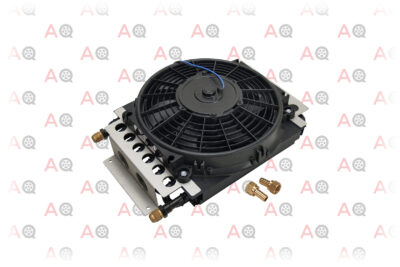
Editor’s Rating:
Best Suited For
The Derale Electra-Cool is perfect for any vehicle owner that values performance. That included towing performance, drift circuit performance, or just dominating highway pulls down in Mexico.
It is fan-cooled and can be mounted anywhere. The fan cooling also keeps it compact enough that it’s easy to find a place to mount it. That makes it ideal for performance cars, newer compact trucks, and custom hotrods. It’s also perfect for old trucks that don’t have much room, or tiny cars that are being pushed too hard, or even motorcycles for your next “Long Way Around” tribute ride. Basically, anywhere you have fluids that need cooling.
Standout Features
The first prominent feature is the design. It’s compact, encased in an aluminum shroud, and includes a high flow fan. The whole package is easy to mount anywhere and will fit in perfectly no matter how crazy your build becomes.
Lending to that notion is the second big feature, the inclusion of AN fittings. It also includes barbed fittings for more universal fitment. If you really value performance, though, the -8AN fittings are how you’ll want to hook this cooler in.
How Does It Compare?
Let’s get the bad out of the way first. It’s a bit expensive, and the fan adds a layer of complexity that simpler units don’t have. If you really want a straightforward, radiator mounted cooler that works with almost any vehicle, the B&M SuperCooler on our list will probably suit you better. It’s cheaper and doesn’t have any moving parts.
If you are willing to tackle the added complexity, the performance to cost to size ratios of the Derale Electra-Cool is best in class.
Pros
- It comes with factory AN fittings
- It’s compact but still cools really well
- The fan and size make it perfect for mounting anywhere
Cons
- It’s more expensive than fanless units
- It’s more complicated than other units and can be intimidating to install
2. Honorable Mention: B&M SuperCooler
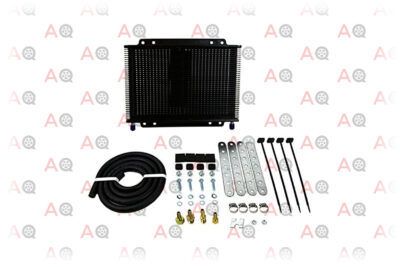
Editor’s Rating:
Best Suited For
The SuperCooler is really for anyone with a truck, SUV, or bigger vehicle who notices that the transmission is getting hot. It’s medium-sized, which is about the standard for most coolers, but it’s a very high-efficiency design. So even though it’s not very big, it still offers a great amount of cooling.
The big deal with the fitment is that the kit the SuperCooler comes in is really complete. You can use the threaded fittings it comes with or use the included barbed adapters. Unfortunately, it doesn’t have AN fittings, so you are better off with something else if you have a racecar.
It does come with bolts and brackets for mounting anywhere, meaning you can almost certainly find a place to install it. Just make sure it has good airflow because it doesn’t have a fan.
Standout Features
The one thing that really stands out about the B&M SuperCooler is the completeness of the package. It’s got threaded fittings with adapters, it’s got bracket mounts and funky zip tie mounts, and it even comes with tubing and hose clamps. It’s missing the bypass valve that the monster Tru-Cool kit we recommend has, but the B&M is half the price. It’s easy to buy a really nice bypass system for the money you’d save.
How Does It Compare?
The B&M cooler is one of the best value coolers you can get. It has tons of cooling potential, it has tons of installation options, and B&M makes a high-quality product.
There’s a lot of reasons that you might choose other products. If you need to install a cooler in a remote location, get the Derale Electra-Cool. If you need even more cooling, pay a lot more and get the Tru-Cool Max. If you want to spend a lot less, get the Hayden 678. If you want the balance between all those things in a simple to install, universal package? The B&M SuperCooler is the cooler for you.
Pros
- It’s very versatile
- High-quality
- Really good cooling efficiency
Cons
- It’s a little expensive for what it is
- No AN fittings
3. Best Heavy Duty Cooler: Tru-Cool Max 40K
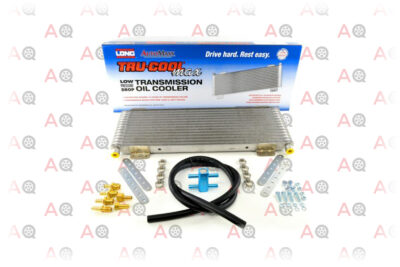
Editor’s Rating:
Best Suited For
This is the mack daddy of cooling, and if you are about to pull a team of horses up to a secluded ranch in the high mountains, then the Tru-Cool Max 40k is for you. It takes up more room than anything else on our list, but the 40k in the name stands for a GVWR of 40,000 lbs. If you can tow that much weight, the size is not going to be an issue.
Standout Features
There are two really great features. First, and most importantly, it’s huge. It has a lot of surface area, it holds a lot of extra fluid, and it allows a ton of air to pull the heat away. That means you get as much cooling as is possible without spending even more and going to a fan cooled unit like the Derale Hyper-Cool.
Second, it’s super simple to install. Tru-Cool includes everything, even bolts. That’s unique for universal kits. Usually, companies make you source out everything. Tru-Cool seems to know that DIY types will love their products, so they go the extra mile. The brackets are pre-mounted to the cooler, it includes multiple different sized fittings and its own bypass.
How Does It Compare?
It’s hard not to say that the Tru-Cool cooler is a fantastic buy. It’s huge, so that eliminates it from many people’s lists, but it works great and is super easy to install. It is costly. However, you might actually save money over similar products because you’d have to buy the extras that the Tru-Cool includes separately.
The hardest part about an oil cooler this big is that if you already have a vehicle set up to tow, chances are it has a big transmission cooler from the factory. It’s a lot of money to spend on something that you may not need. If you are noticing some overheating while towing heavy loads, though, the Tru-Cool is the way to go.
Pros
- It’s great for towing
- It’s easy to install and includes almost any fitting you could need
- The included bypass valve is a nice feature
Cons
- Expensive
- It’s too big for most vehicles, and vehicles big enough to utilize it might already have a good cooler
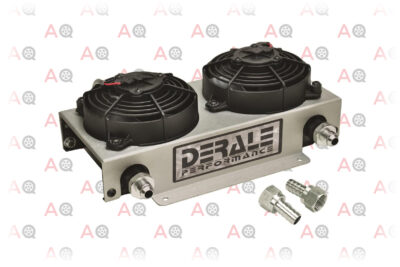
Editor’s Rating:
Best Suited For
The Hyper-Cool Dual is all about high-performance. It’s a bit complicated for just being a heavy towing cooler. The Tru-Cool cooler.
is just fine for large trucks, but if you are about to enter the King of Hammers competition, the Hyper-Cool is terrific.
It’s ultra-compact for the amount of cooling it produces. With two fans pushing air through the stacked plate system, you can get some of the best cooling on this list from a system that will fit anywhere and can be mounted anywhere. Dragsters, hardcore offroad buggies, and honestly just about any high-performance build where cooling is a very high priority can benefit from this Derale.
Standout Features
There’s a lot that stands out. First, it’s got two fans, so there’s a ton of cooling no matter where it’s placed. Second, it’s set up from the factory for custom and modified vehicles, with AN fittings and an aluminum shroud. Third, and perhaps most astonishingly, is the insane amount of cooling.
The Hyper-Cool Dual disperses more than 3 times the amount of heat as a really great tow cooler like the B&N SuperCooler. You read that correctly; the Hyper-Cool dwarfs most other coolers in terms of cooling performance.
How Does It Compare?
You’ll be paying a lot for that, though. It’s the most expensive thing on our list. If you don’t need that level of cooling, you’re spending a lot of money just to move air around. Also, like many high-performance parts, it’s just not noob friendly at all. If you are not comfortable doing a lot of wiring, you’ll be in for a bad time. Both the fans should be wired to separate controllers, and the whole thing should be wired into thermostat switches to keep everything optimal.
After you tackle the wiring, you need to plumb it in. Even though it comes with universal adapters, the only way to take advantage of the cooling is to have a robust system setup with bypasses. Trust us, if you are just getting into performance modifications, get the G-Plus cooler instead. When you outgrow it, come back for this Derale.
Pros
- It has insane amounts of cooling performance
- It’s ready from the factory to drop into high-performance vehicles
- It can be mounted anywhere
Cons
- It’s really expensive
- You do need a high level of knowledge and skill to fully utilize it
5. Best Budget Cooler: Hayden Transaver
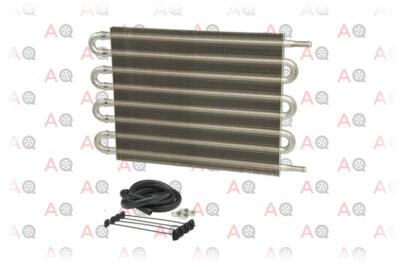
Editor’s Rating:
Best Suited For
The Hayden Transaver is perfect for anyone that just needs a bit more cooling. It’s not going to stop you from overheating while towing a motorhome up a mountain. However, it will stop your truck from overheating as you pull a motorcycle trailer through the desert. This unit is just a perfect first step when you notice that you are running hot. It’s cheap enough that you can throw it on and see if it solves the problem before committing to a larger, more expensive unit.
They even made it moderately easy to mount. It’s medium-sized, so it will fit in almost anything as long as air can flow through it, and it includes its own tubing and push-on fittings. It’s a shame they didn’t attach any brackets for easier mounting, but the standard zip tie like things will suffice.
Standout Features
There really aren’t any; it’s about as straightforward as a cooler can be. It has a tube, some fins, and it comes with some tubing. That’s not a bad thing. It means nothing can break, but it can make it feel like other coolers are a much better value despite the low price.
How Does It Compare?
It’s a little unfair to compare this budget item to premium items like the B&M cooler. Yes, the Hayden Transaver is lower quality, is harder to install, and frankly looks uglier. It’s one-third the price, though, and that can forgive a lot of sins.
What is a fair comparison is to compare this Hayden to the other Hayden cooler on our list. They are about the same size, both use universal fittings, and both are under $50. This is where we have to be honest with you all and say that unless saving ten or so dollars is really important to you, you should get the Hayden 678 instead. The 678 is a lot more efficient. It’s about the same size, but it has more than twice the cooling power.
However, as we said before, the Hayden Transaver is a perfect first step. That’s where the price really matters. If you just are not sure if a cooler will solve the problem or are really worried about fitment, you can buy the Transaver and give the idea a good test.
Pros
- It’s Inexpensive
- It’s simple and durable
- It will fit a really large variety of cars and trucks
Cons
- It doesn’t cool very good for its size
- The fit and finish leaves a bit to be desired
6. Best Towing Cooler: Hayden Automotive 678
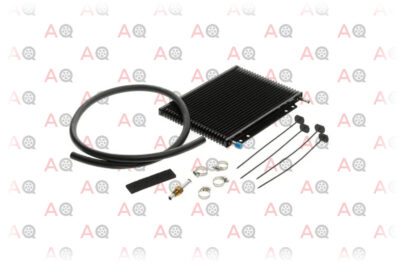
Editor’s Rating:
Best Suited For
The Hayden 678 is too big for small vehicles, but it’s got a ton of cooling potential. It’s got a GVWR of up to 24,000 pounds. For reference, that’s a motorhome towing a Jeep, or a 1-ton truck towing a few horses. That means for your average truck, this cooler is more than enough to keep your transmission from overheating.
Unlike really gigantic units like the Tru-Cool Max, the Hayden 678 is still a reasonable size and easy to shoehorn into older trucks that don’t have adequate factory cooling. For that reason, it’s easy to say that this Hayden cooler is the best general-purpose truck cooler on our list.
Standout Features
For a budget, fanless cooler, the efficiency is fantastic. To put it into context, it’s only a little bit bigger than one of our favorite coolers, the B&M SuperCooler. Despite that, it has very similar cooling properties.
How Does It Compare?
There are two main competitors on our list for the Hayden Automotive 678. The first one is one we mentioned above, the B&M SuperCooler. That doesn’t make for a very flattering comparison, though. They might have similar cooling capabilities, but the Hayden is lower quality, uses weaker metals, and is harder to mount. It’s a lot cheaper, but that’s about it.
For a much more flattering comparison, let’s contrast it with the other Hayden cooler on our list, the Transaver. The 678 is about ten dollars more, but for those extra dollars, you get a unit that is a lot easier to install and has a much higher cooling efficiency. If you tow a lot, the 678 is just a much better option, and you won’t regret paying for it.
Pros
- It’s inexpensive
- It’s easy to install
- It’s great for towing
Cons
- The quality could be better
- It doesn’t have AN fittings
7. Best for Small Cars: VRacing 4 Row Universal
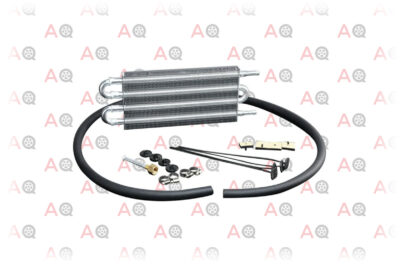
Editor’s Rating:
Best Suited For
If you need a cooler for towing a big trailer through the desert, this isn’t it. But if you have a small truck and just need a bit more cooling as you haul loads up long hills, this is perfect. The 4 Row is also perfect if you notice that your car is overheating on hot days. It doesn’t have a fan, so it needs to be mounted in front of your radiator, but it’s small enough that that isn’t an issue.
They claim it’s for performance cars too, but the reality is that most performance cars will be begging for the remote install capability that a unit with a fan will bring. Small trucks and cars that live in harsher climates or that are driven just a bit harder than they are meant for will really benefit from a small cooler like this, though.
Standout Features
It’s small and doesn’t cost much, but it doesn’t really stand out in any way. That’s not a bad thing. There’s nothing to go wrong with it, which can be just as valuable as any feature. There’s also nothing that makes it hard to work with. There’s no fan to figure out how to wire in and no AN fittings to adapt. It’s just, there’s also nothing that really makes it unique.
How Does It Compare?
It’s half the size of the Hayden Automotive 678 and less than half the cost. It’s also less than half the cooling power, so it all works out. If that’s all you need, then it’s perfect.
The simplicity of this cooler can lead to a few disadvantages. It has like, no install hardware. You basically just have to zip-tie it to a structural member. Second, the cooling efficiency isn’t high. On a small unit like this, efficiency is key to cooling performance, so that’s not great. It’s so cheap, though, it’s actually hard to criticize it too harshly.
Pros
- It’s very inexpensive
- It’s great for small vehicles where space is a concern
- The simple design means there’s nothing that can break
Cons
- You will have to find a DIY solution for mounting it
- Not good for larger vehicles
8. Best Fan Cooled Cooler: G-Plus Racing Cooler
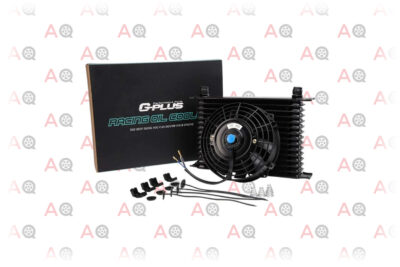
Editor’s Rating:
Best Suited For
Budget builders rejoice because the G-Plus is the perfect addition to any modified vehicle. It’s inexpensive enough to throw on an old K5 that needs to tow a travel trailer, and it’s approachable enough to stick on your old CRX before entering into the autocross.
The fan lets it work in any position, and it’s small enough to fit anywhere. The only issue that this G-Plus has is the opposite issue of the Mishimoto cooler on our list. For some reason, the G-Plus comes with AN fittings but no adapters. You’ll have to buy your own adapters if you want to make sure it fits your old work truck.
Standout Features
The price is the thing that makes the G-Plus standout. It is less than half the cost of the Derale electric cooler. You sacrifice quality for that price, and it shows in the finish of the unit. For instance, the seams aren’t sanded down, which is something you would never see on a higher quality cooler.
What you can do with a cheaper unit like this one is to test out the process before committing to a much more expensive setup. If you are on the fence about getting a cooler with a fan, then you can pick this up without feeling like you wasted a ton of money.
How Does It Compare?
As we said above, it’s the least expensive cooler with an electric fan on our list. We know that no one hates saving money, so we’ll count that as a good thing. It also comes in blue, if you want to add some color to your system.
It’s not all sunshine and rainbows, though. Like we said before, it’s just not as high quality as the more expensive counterparts. It won’t cool as well as the Mishimoto cooler, despite being a similar size, and the threaded inputs can be intimidating for first time DIYers. Oh, it’s also got terrible documentation. They even proudly proclaim that they don’t include instructions in the ad.
Pros
- Inexpensive
- Can be mounted anywhere
- Perfect for learning about transmission coolers and your vehicle
Cons
- The quality could be better
- The lack of universal fittings in the kit is annoying
9. Best Racing Cooler: Mishimoto MMOC-F
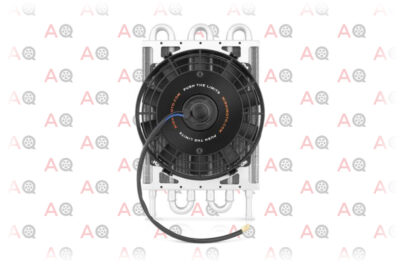
Editor’s Rating:
Best Suited For
At first glance, it doesn’t seem like the Mishimoto brings anything new to the table. It looks like the Derale Electra-Cool, and it costs about the same. It’s a lot smaller, though, which means you can stick it in tight engine bays while still getting excellent cooling from the attached electric fan. It’s perfect for old Jeeps where space is a huge issue under the hood, but where we think it shines is on track weapons.
Yes, we know that most track day people would turn up their noses at an automatic transmission. There’s a great oil cooler by Mishimoto here for those of you who live the three-pedal life. Not everyone does, though, and plenty of people enjoy driving modified automatics. Especially the quarter-mile junkies, and they need to keep those automatic transmissions cool if they want the best possible ET. Weight, space, and compatibility are all at a premium when building a vehicle like that. This Mishimoto fits the bill.
Standout Features
The 8” heavy-duty fan is the biggest thing that makes this Mishimoto awesome. That allows you to install it totally out of position if you need to, and keeps you cool while staging at the lights.
How Does It Compare?
It’s a lot more expensive than the G-Plus cooler on our list, so it’s got to be pretty good to be worth it. The good news is that it is worth the extra price if you need the most cooling possible out of a compact unit. It’s a very well built unit, and it comes with a lifetime warranty.
There is one big gripe we have with it, though. Usually, when you are building a high-performance car, you will almost always be switching to AN fittings at some point. Unfortunately, Mishimoto went for the more universal push fittings instead.
To give you an idea of how close a lot of these compact units compare, the inclusion of AN fittings is the only reason we like the Derale Electra-Cool better. The Mishimoto cooler is still absolutely fantastic.
Pros
- The fan is really good
- It’s easy to install because of the universal fittings
- It’s very compact
Cons
- It’s expensive for the size
- We wish it had AN fittings and adapters instead of the straight universal connections
10. Best Tiny Cooler: Derale Compact Fluid Cooler
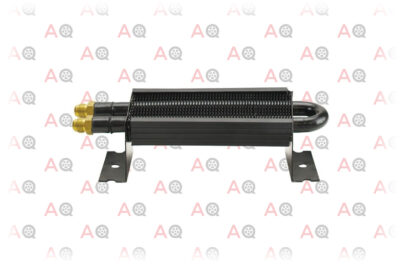
Editor’s Rating:
Best Suited For
It’s a little cooler for little things. It’s not even big enough to cool the transmission in your civic. You could stack a bunch of them together or something, but there are approximately 9 better ways on this list to cool a large transmission. Even if space is your biggest concern, a unit with a fan like the G-Plus cooler mounted in a remote location would be better than the relatively small surface area of this Derale.
Got a dirt bike, automatic scooter, or side-by-side, though? This little thing is perfect for keeping the transmission oil cool.
Standout Features
The size is really the most significant design element for this Derale. It comes stock with -6AN fittings, so you’ll have to convert it to barbed fittings to get a really universal fitment, but it’s small enough that it will fit on anything.
How Does It Compare?
When it comes down to it, the Derale Compact is just not big enough to be really useful for most transmissions, and that’s why we rated it so low. It’s really not a bad unit. Like most Derale products, it’s high quality and easy to mount. It’s perfect as a power steering cooler and perfect for cooling the oil on a motorcycle or other small engine. If you are looking for versatility, the size and AN fittings make it a great choice.
The problem is that they market it as an auxiliary transmission cooler, so we are reviewing it as such. It might lower your ATF temp a few degrees, but that’s nothing compared to the -20 you get from a small dedicated cooler like the VRacing 4 Row. The real kicker, though, is that the VRacing cooler is cheaper.
Pros
- It’s tiny. Perfect for motorcycles and stuff
- It has a high build quality
- It comes stock with -6AN fittings
Cons
- It’s kind of expensive for what it is
- It’s tiny, and that means it’s not very good at cooling transmissions
Everything You Could Want to Know About Transmission Coolers
Up above, we promised you science, details, and tons of extra information. We like to keep our word, so let’s get into it. We’ll start with a deeper dive into the most important question.
Reasons to Buy a Transmission Cooler
If you go on to forums or follow truck builds on Instagram, you’re probably convinced that the minute you try to tow even the smallest trailer with your vehicle, it will instantly catch fire and explode. Unless, of course, you have a transmission cooler.
Here’s the big secret, though: the people who design and manufacture trucks aren’t idiots. Most trucks, SUVs and even a lot of cars already have a transmission cooler integrated into the radiator. In fact, it’s usually better and more efficient than a lot of aftermarket ones. Unless you are actually noticing signs of your transmission overheating, then the answer is probably no.
There are a handful of good reasons to get an aftermarket cooler, though. Some don’t even require you to be having a problem first.
Your Transmission Is Overheating
You can read about the signs here offsite, but the basic idea is that an overheating transmission will smell bad and behave strangely. There are a few reasons a transmission can start overheating. There could simply be a design flaw for that make and model, or the owner could live in a really harsh and hot environment.
The first thing to check is the fluid quality. Bad or old fluid will cause overheating, so don’t jump straight into installing hundreds of dollars worth of upgrades when twenty dollars worth of ATF will do you just fine.
You Plan on Making the Transmission Do Extra Work
If you plan on really taxing the tranny, an oil cooler can save you from issues. Racing or towing heavy loads frequently can put a serious strain on a transmission and cause the temperatures to climb higher than the maker designed them for. Especially if you have a car or truck that doesn’t have a factory cooler.
You Are Messing With the Factory System Anyway
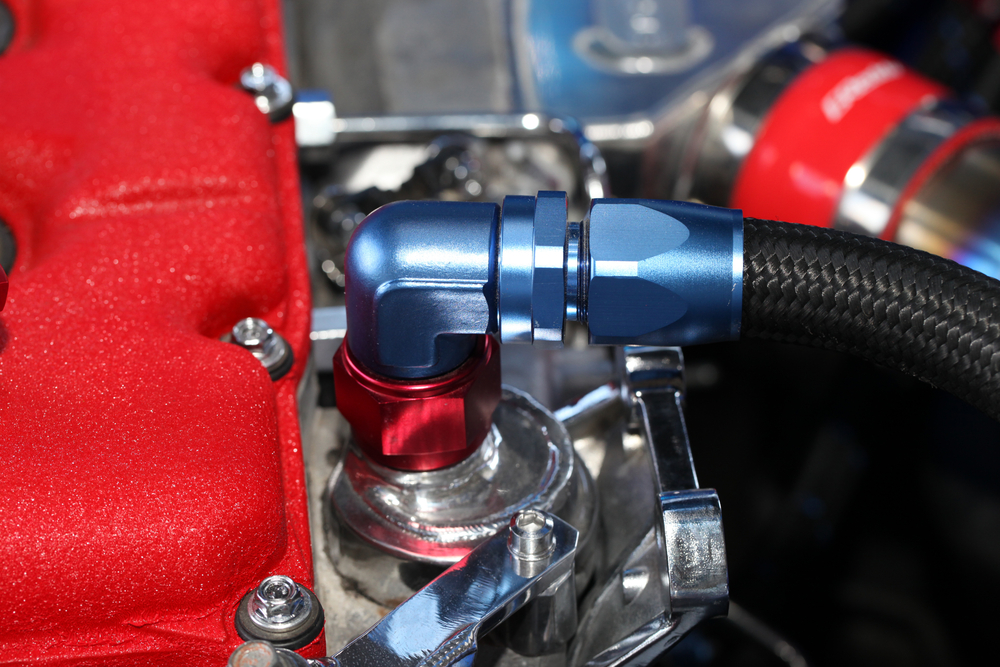
Modifying cars is a lot of fun. Any time you build power, you will probably also have to overhaul your cooling system. Most big aftermarket radiators won’t have an integrated transmission cooler, so you’ll need to buy a separate unit to ensure things stay under temp. What can be really handy about an aftermarket oil cooler is the ability to mount it anywhere. Depending on the extent of the modifications you are doing, you may be forced into buying an aftermarket cooler just because there isn’t room for the factory system anymore.
AN Fittings, Barbed Fittings, and Hose Clamps
After reading through our reviews, you might have some questions. Questions like, what is an AN fitting, and why do they keep talking about it? Why is an AN fitting better than a press on fitting, and why are all these press fittings different shapes?
Well, we’d like to answer those questions here.
AN Fittings
AN stands for Army Navy, because they were developed by the Army and the Navy. If you really want to know more, you can read the wikipedia entry about them here.
More importantly, AN fittings are standardized, threaded fittings for fluids used everywhere in the automotive world. They are measured by a dash number, and the higher the number, the bigger the fitting.
If you have ever gone to a place where there are a lot of high performance or custom cars, you’ve seen AN fittings everywhere, usually -8 and -10 fittings. Those are kind of your standard race car sizes. They are almost always either red or blue, and they are on the end of those cool braided hoses that run from reservoirs, to pumps, to filters, to coolers, and to the motor.
Push-on or Barbed Fittings
Push on fittings have a ton of different designs, but they all function in the same way. You push a rubber hose over a tube that has ribs, barbs, or a bump to hold the rubber hose in place. Then you tighten a hose clamp around it.
They are dead simple and can be used with a lot of different types of hoses. You can even fudge the sizes. A hose barb that is too small for a hose can be made to work if you put enough force into the clamp, and a hose that is to small for the hose barb can be heated up and worked onto it anyway.
These types of connections are prone to wearing out and leaking, though. They can also be an absolute pain in the butt to work with after some time passes. Rubber hoses are especially prone to seizing in place. If a hose is older, you are much better off cutting it with a knife and replacing it rather than trying to carefully remove it and reuse it.
Threaded Fittings
Some of the coolers we recommend, like the B&M cooler, have threaded fittings that are not AN fittings. These threaded fittings are meant to be used with an adapter. You can either screw-in push on fittings or AN fittings. The advantages of having a threaded inlet and outlet are that you can choose what method you will use to hook up the oil lines, and they don’t have to be the same method for the in and the out. The downside is that you have to do some extra legwork to buy the adapter and install it.
The Three Main Types of Cooler
We touched on it briefly up above, but in addition to either having a fan or not, coolers come in three main types. The biggest differences between them are the efficiency of cooling and the price. The higher the efficiency, the more they cost. That usually means your budget will determine the type, so it’s not a very important thing to think about.
- Tube and Fins– Cheap coolers like the Hayden Transaver are just a metal tube connected by metal fins. The heat gets absorbed from the tube by the fins and dispersed into the air. Simple, cheap, and good enough to cool things down a few degrees.
- Plates and Fins- Plates are kind of like flat tubes. If you take a look at the Hayden 678 you’ll see that it has a ton of flat “plates” connected by a ton of tiny “fins.” The plates and fins design is higher efficiency because of the greater surface area, but the extra metal tends to make it cost more.
- Stacked Plate- A stacked plate design is used in most premium coolers, like the B&M cooler we recommend. At first glance, they look just like the plate and fin designs, but they are engineered to allow way better airflow and even more surface area. That engineering costs money, though.
A Transmission Cooler Is Part of a System
The last thing we really want to touch on in this guide is to reinforce the fact that a transmission cooler is part of a system. It’s not enough to just buy a cooler and bolt it onto your truck; you also need to think about other vital components.
Thermostats and Bypasses
There is actually a sweet spot between too cold and too hot when it comes to most fluids. Your engine’s cooling system has a thermostat that only opens when the motor is warmed up. When you install a transmission cooler, you want it to behave in the same manner.
You do that by creating a bypass loop so that the transmission fluid can flow through the stock internals and warm up without having to flow through the aftermarket cooler. There are electric thermostats that hook up to bypasses controlled by an electric signal, and bypasses that work like a radiator thermostat. You will want to research since builds are more dependent on the individual vehicle than anything else.
Space Conflicts
Not only are there components that make up the transmission cooling system, but the transmission itself is part of a larger system that makes up your power train. That means you have to be careful to install coolers and hoses in a place where they will not interfere with other components. A fancy new cooler won’t do you any good if the radiator fan cuts the hose in half.
Relays and Wiring
Coolers with a fan have an extra step when installing them, and that extra step is wiring in the fan. Generally, you don’t want the fan to run all the time, and that’s for the same reason you would install a bypass. When the engine is cold, you are just wasting energy by letting the fan run constantly. The easiest thing to do is get a thermal switch, like this one, and wire the fan into it.
Otherwise, wire into a relay that’s triggered off the main thermostat or the computer. If you are hardcore, wire it to a switch on your dash and just turn it on when you need it.
Keep It Cool
The number one killer of performance transmissions is heat. There’s no reason not to solve that issue. Coolers range from cheap to still less than a good intake, and it’s a small price to pay compared to the thousands of dollars it would take to replace a transmission that you know is running hot. Don’t wait; grab some zip ties and some ATF and order one.


